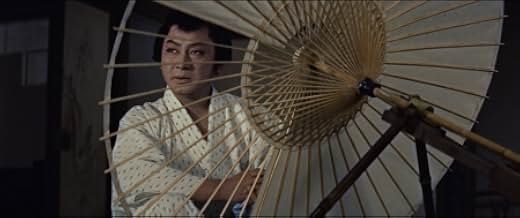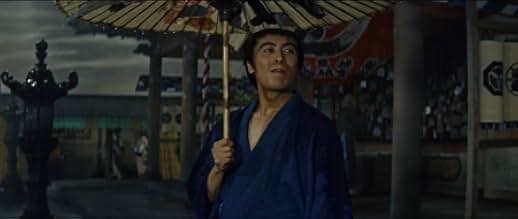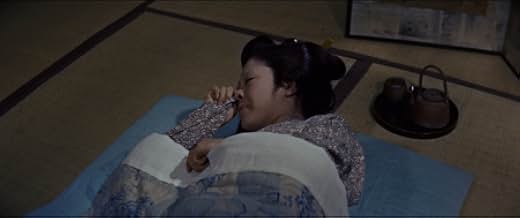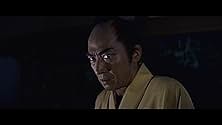Tôkaidô Yotsuya kaidan
- 1959
- 1 Std. 16 Min.
IMDb-BEWERTUNG
7,0/10
2027
IHRE BEWERTUNG
Füge eine Handlung in deiner Sprache hinzuThe ghost of a samurai's wife takes revenge on her husband.The ghost of a samurai's wife takes revenge on her husband.The ghost of a samurai's wife takes revenge on her husband.
- Regie
- Drehbuch
- Hauptbesetzung
Katsuko Wakasugi
- Iwa
- (as Kazuko Wakasugi)
Haruhiko Nakagawa
- Yomoshichi Satô
- (as Ryûzaburô Nakamura)
Empfohlene Bewertungen
This classic japanese tale has been filmed many times. It's the story of a samurai's betrayal of his wife and the ultimate vengeance her spirit seeks. The spectre of her ghost haunting the mind of her husband is almost like seeing a japanese "The Shining".
Shigeru Amachi wants to marry Katsuko Wakasugi, the daughter of prominent samurai Shinjirô Asano. Asano refuses the request, belittling Amachi who promptly murders him. Shuntarô Emi witnesses the murder and promises to help him cover it up, if he in turn helps him marry Wakasugi's sister. The two tell Wakasugi that her father was murdered by a notorious criminal and they will help her get revenge. Instead, they murder her sister's fiancé and Emi runs off with her.
Months later, Amachi and Wakasugi are married and living in Edo. Amachi has fallen for Junko Ikeuchi, the daughter of a nobleman, and hatches a plan to rid himself of Wakasugi. He hires Jun Ôtomo to seduce her so that he can legally kill her, but the plan goes awry. Ôtomo ends up dead and Wakasugi is poisoned causing hideous facial deformities before she also dies. Amachi marries Ikeuchi, but the spirits of Wakasugi and Ôtomo haunt him leading him to ruin.
This is probaby the best known adaptation of the kabuki play "Yotsuya Kaidan" (there are many). It's a fairly routine film from a story and characters perspective, but the film's vibrant colours and gory, hallucinatory visuals are really something.
Months later, Amachi and Wakasugi are married and living in Edo. Amachi has fallen for Junko Ikeuchi, the daughter of a nobleman, and hatches a plan to rid himself of Wakasugi. He hires Jun Ôtomo to seduce her so that he can legally kill her, but the plan goes awry. Ôtomo ends up dead and Wakasugi is poisoned causing hideous facial deformities before she also dies. Amachi marries Ikeuchi, but the spirits of Wakasugi and Ôtomo haunt him leading him to ruin.
This is probaby the best known adaptation of the kabuki play "Yotsuya Kaidan" (there are many). It's a fairly routine film from a story and characters perspective, but the film's vibrant colours and gory, hallucinatory visuals are really something.
Tired of living in poverty with his wife, a samurai hatches a scheme to kill her off so he can marry a wealthier woman which he carries out successfully, but her ghost returns to torment him for the wrongful death and must find a way to stop it before he is condemned for eternity.
This is one of the most enjoyable and faithful variations of the story. Even though most of them are going to be pretty much similar to what happens, this one goes for a straight retelling of the story which comes off decently. With the first half retelling their life in poverty together, these reinforcements of the society gap between the two becomes heavily integrated with the original story which isn't that action-packed yet wholly sets up the ghostly vengeance later on. When the murder happens and the ghostly stuff starts to happen, it gets infinitely better through the use of actually having stuff happening as those allow this one to surprisingly become far more watchable. With the last part of the film taken up by this use of classic Gothic horror tropes as the visions of the two ghosts appearing around the huts or appearing out of the swamp, moaning and madness all start to come into play here in a series of long, extended scare scenes that take on a fine form of revenge against him and even does correct some flaws found here. It doesn't have too many flaws about it to hold it back. The first half of this film has absolutely nothing of any real value as a horror film at all, looking absolutely like a lame drama about the social standing rather than anything to do with a ghost story, and it makes for some utterly boring and not at all interesting times. The endless talks of him trying to get a better life, the prodding from his friend who knows too much and the interactions with the wife all compound together to make this a pretty bland part of the story. As well, the film also really looks it's age with the set-based look of the villages and the cramped, confined feel completely destroys the intent of being out in the countryside the way it should be. The positives counteract some of these issues but not all of them, leaving this as a rather interesting take on the story but overall not much else.
Rated Unrated/PG-13: Violence.
This is one of the most enjoyable and faithful variations of the story. Even though most of them are going to be pretty much similar to what happens, this one goes for a straight retelling of the story which comes off decently. With the first half retelling their life in poverty together, these reinforcements of the society gap between the two becomes heavily integrated with the original story which isn't that action-packed yet wholly sets up the ghostly vengeance later on. When the murder happens and the ghostly stuff starts to happen, it gets infinitely better through the use of actually having stuff happening as those allow this one to surprisingly become far more watchable. With the last part of the film taken up by this use of classic Gothic horror tropes as the visions of the two ghosts appearing around the huts or appearing out of the swamp, moaning and madness all start to come into play here in a series of long, extended scare scenes that take on a fine form of revenge against him and even does correct some flaws found here. It doesn't have too many flaws about it to hold it back. The first half of this film has absolutely nothing of any real value as a horror film at all, looking absolutely like a lame drama about the social standing rather than anything to do with a ghost story, and it makes for some utterly boring and not at all interesting times. The endless talks of him trying to get a better life, the prodding from his friend who knows too much and the interactions with the wife all compound together to make this a pretty bland part of the story. As well, the film also really looks it's age with the set-based look of the villages and the cramped, confined feel completely destroys the intent of being out in the countryside the way it should be. The positives counteract some of these issues but not all of them, leaving this as a rather interesting take on the story but overall not much else.
Rated Unrated/PG-13: Violence.
This film essentially begins with a young samurai by the name of "Iemon Tamiya" (Shigeru Amachi) asking a more high-level samurai named "Samon Yotsuya" (Shinjiro Asano) to marry his daughter "Iwa Yotsuya). In response, Samon angrily refuses because he considers Iemon to be much too hedonistic and of low-moral character. Not surprisingly, this infuriates Iemon and, as if to prove Samon's point-he furiously draws his sword and kills the older man on the spot. Having witnessed the murder and wanting to capitalize on it, a cunning peasant named "Naosuke" (Shuntaro Emi) appears from the shadows and advises Iemon on exactly what to do next. Needless to say, Iemon listens quite intensely and in relatively little time he does, in fact, marry Iwa. Likewise, Naosuke also gets closer to realizing his ambition of marrying Iwa's sister "Sode" (Noriko Kitazawa) who was always out of reach for him due to his low status in life. However, what neither Iemon or Naosuke realize is that, eventually, their evil deeds will catch up to them--and when they do--they come in a most bizarre manner. Now, rather than reveal any more, I will just say that this was a good horror film which took a bit of time laying down the foundation of the story before really increasing in intensity later on. Admittedly, the costumes and makeup used pale in comparison to the CGI and special effects found in more modern films of today. No question about it. But even so, I thought that the overall movie was still quite entertaining, and I have rated it accordingly.
Funny how things change. In 1949 Shintoho was producing prestige films like Akira Kurosawa's STRAY DOG. Ten years later they were producing scores of everything from lurid melodramas to nationalist war movies to cheap gangster flicks to kaidan period horror movies like this. Two years later, in 1961, they declared bankruptcy and closed shop, the first semi-big studio in postwar Japan to do so. Nobuo Nakagawa, along with Teruo Ishii who graduated from the film noir of the Chitai series into full blown sleaze and torture 10 years later, was one of those prolific studio filmmakers responsible for many of their kaidan pictures. His biggest call to fame is JIGOKU from the following year but this is an ample showcase of both the good and the bad of Shintoho film-making.
Based on the classic story by Nanboku Tsuruya about a conniving lowly samurai who is haunted by the ghost of the wife he murdered, a lot of the drama is hackneyed, the characters simple caricatures of good and evil, innocent and scheming, the dialogues delivered on-the-nose. Iemon, the murderous samurai, is played and depicted as the worst villain possible. No grey areas here, nothing morally ambiguous, the movie is melodrama played to the back of the house. And yet, the first appearance of the ghost sent chills down my spine. Ringu and Ju On didn't invent the pale-faced ghost that creeps along the edge of the frame. It was there 50 years ago and in Kabuki theater before that.
With the eye of a stylist, Nakagawa orchestrates a vision of hell on earth, ghosts rising from the ground or peering down from the ceiling, and it's all very stagey and theatrical probably to appeal to an audience already familiar with the story from Kabuki theater and as much creepy/atmospheric as it is graphic, certainly more graphic than American horror would dare to be for the next 10 years (we have blood gushing from wounds, facial deformities, and even an amputated limb), and while the whole is never as good as the parts, those parts should appeal to the horror fan who likes his lighting bright red and torquoise and his ghosts slow-moving and disfigured.
Based on the classic story by Nanboku Tsuruya about a conniving lowly samurai who is haunted by the ghost of the wife he murdered, a lot of the drama is hackneyed, the characters simple caricatures of good and evil, innocent and scheming, the dialogues delivered on-the-nose. Iemon, the murderous samurai, is played and depicted as the worst villain possible. No grey areas here, nothing morally ambiguous, the movie is melodrama played to the back of the house. And yet, the first appearance of the ghost sent chills down my spine. Ringu and Ju On didn't invent the pale-faced ghost that creeps along the edge of the frame. It was there 50 years ago and in Kabuki theater before that.
With the eye of a stylist, Nakagawa orchestrates a vision of hell on earth, ghosts rising from the ground or peering down from the ceiling, and it's all very stagey and theatrical probably to appeal to an audience already familiar with the story from Kabuki theater and as much creepy/atmospheric as it is graphic, certainly more graphic than American horror would dare to be for the next 10 years (we have blood gushing from wounds, facial deformities, and even an amputated limb), and while the whole is never as good as the parts, those parts should appeal to the horror fan who likes his lighting bright red and torquoise and his ghosts slow-moving and disfigured.
Wusstest du schon
- VerbindungenFeatured in Building the Inferno: Nobuo Nakagawa and the Making of 'Jigoku' (2006)
Top-Auswahl
Melde dich zum Bewerten an und greife auf die Watchlist für personalisierte Empfehlungen zu.
- How long is The Ghost of Yotsuya?Powered by Alexa
Details
- Laufzeit1 Stunde 16 Minuten
- Seitenverhältnis
- 2.35 : 1
Zu dieser Seite beitragen
Bearbeitung vorschlagen oder fehlenden Inhalt hinzufügen

Oberste Lücke
By what name was Tôkaidô Yotsuya kaidan (1959) officially released in India in English?
Antwort

















